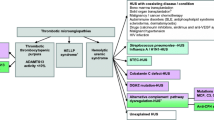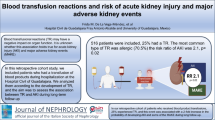Abstract
Background
The longitudinal relationship between HLA class I and II eplet mismatches, de novo donor-specific antibodies (dnDSA) development, and acute rejection after transplantation in childhood is unknown.
Methods
Eplet mismatches at HLA class I and II loci were calculated retrospectively for each donor/recipient pair transplanted between 2005 and 2015 at a single Australian center. Logistic regression analyses were conducted to determine the association between the number of eplet mismatches, dnDSA, and acute rejection.
Results
The cohort comprised 59 children (aged 0–18 years) who received their first kidney allograft and were followed for median (interquartile range) 4.5 (± 2.6) years. Overall, 32% (19/59) developed dnDSA (class I 3% (2/59), class II 14% (8/59), 15% class I and II (9/59)), and 24% (14/59) developed biopsy-proven acute rejection. Every unit increase in class I and II eplet mismatches corresponded to an increase in risk of class I (odds ratio (OR) 1.22, 95% CI 1.07–1.39, p < 0.01) and class II (OR 1.06, 95% CI 1.01–1.11, p = 0.02) dnDSA development. Compared with recipients without dnDSA, class I and II dnDSA were associated with direction of effect towards increased risk of acute cellular rejection (class I: OR 5.87, 95% CI 0.99–34.94, p = 0.05; class II: OR 12.00, 95% CI 1.25–115.36, p = 0.03) and acute antibody-mediated rejection (class I: OR 25.67, 95% CI 3.54–186.10, p < 0.01; class II: OR 9.71, 95% CI 1.64–57.72, p = 0.01).
Conclusions
Increasing numbers of HLA class I or II eplet mismatches were associated with the development of dnDSA. Children who developed dnDSA were also more likely to develop acute rejection compared with children without dnDSA.



Similar content being viewed by others
References
Duquesnoy RJ (2006) A structurally based approach to determine HLA compatibility at the humoral immune level. Hum Immunol 67:847–862
Sapir-Pichhadze R, Tinckam K, Quach K, Logan AG, Laupacis A, John R, Beyene J, Kim SJ (2015) HLA-DR and -DQ eplet mismatches and transplant glomerulopathy: a nested case-control study. Am J Transplant 15:137–148
Wiebe C, Pochinco D, Blydt-Hansen TD, Ho J, Birk PE, Karpinski M, Goldberg A, Storsley LJ, Gibson IW, Rush DN, Nickerson PW (2013) Class II HLA epitope matching-a strategy to minimize de novo donor-specific antibody development and improve outcomes. Am J Transplant 13:3114–3122
Wiebe C, Nevins TE, Robiner WN, Thomas W, Matas AJ, Nickerson PW (2015) The synergistic effect of class II HLA epitope-mismatch and nonadherence on acute rejection and graft survival. Am J Transplant 15:2197–2202
Chesnaye NC, van Stralen KJ, Bonthuis M, Groothoff JW, Harambat J, Schaefer F, Canpolat N, Garnier A, Heaf J, de Jong H, Schwartz Sorensen S, Tonshoff B, Jager KJ (2017) The association of donor and recipient age with graft survival in paediatric renal transplant recipients in a European Society for Paediatric Nephrology/European Renal Association-European Dialysis and Transplantation Association Registry study. Nephrol Dial Transplant 32:1949–1956
Van Arendonk KJ, Boyarsky BJ, Orandi BJ, James NT, Smith JM, Colombani PM, Segev DL (2014) National trends over 25 years in pediatric kidney transplant outcomes. Pediatrics 133:594–601
Singh P, Filippone EJ, Colombe BW, Shah AP, Zhan T, Harach M, Gorn C, Frank AM (2016) Sensitization trends after renal allograft failure: the role of DQ eplet mismatches in becoming highly sensitized. Clin Transpl 30:71–80
Van Arendonk KJ, Garonzik Wang JM, Deshpande NA, James NT, Smith JM, Montgomery RA, Colombani PM, Segev DL (2013) Practice patterns and outcomes in retransplantation among pediatric kidney transplant recipients. Transplantation 95:1360–1368
Kosmoliaptsis V, Gjorgjimajkoska O, Sharples LD, Chaudhry AN, Chatzizacharias N, Peacock S, Torpey N, Bolton EM, Taylor CJ, Bradley JA (2014) Impact of donor mismatches at individual HLA-A, -B, -C, -DR, and -DQ loci on the development of HLA-specific antibodies in patients listed for repeat renal transplantation. Kidney Int 86:1039–1048
von Elm E, Altman DG, Egger M, Pocock SJ, Gotzsche PC, Vandenbroucke JP, Initiative STROBE (2014) The Strengthening the Reporting of Observational Studies in Epidemiology (STROBE) statement: guidelines for reporting observational studies. Int J Surg 12:1495–1499
Fidler S, D’Orsogna L, Irish AB, Lewis JR, Wong G, Lim WH (2018) Correlation and agreement between eplet mismatches calculated using serological, low-intermediate and high resolution molecular human leukocyte antigen typing methods. Oncotarget 9:13116–13124
Tait BD, Susal C, Gebel HM, Nickerson PW, Zachary AA, Claas FH, Reed EF, Bray RA, Campbell P, Chapman JR, Coates PT, Colvin RB, Cozzi E, Doxiadis II, Fuggle SV, Gill J, Glotz D, Lachmann N, Mohanakumar T, Suciu-Foca N, Sumitran-Holgersson S, Tanabe K, Taylor CJ, Tyan DB, Webster A, Zeevi A, Opelz G (2013) Consensus guidelines on the testing and clinical management issues associated with HLA and non-HLA antibodies in transplantation. Transplantation 95:19–47
Haas M, Loupy A, Lefaucheur C, Roufosse C, Glotz D, Seron D, Nankivell BJ, Halloran PF, Colvin RB, Akalin E, Alachkar N, Bagnasco S, Bouatou Y, Becker JU, Cornell LD, van Huyen JPD, Gibson IW, Kraus ES, Mannon RB, Naesens M, Nickeleit V, Nickerson P, Segev DL, Singh HK, Stegall M, Randhawa P, Racusen L, Solez K, Mengel M (2018) The Banff 2017 Kidney Meeting Report: revised diagnostic criteria for chronic active T cell-mediated rejection, antibody-mediated rejection, and prospects for integrative endpoints for next-generation clinical trials. Am J Transplant 18:293–307
Williams RC, Opelz G, McGarvey CJ, Weil EJ, Chakkera HA (2016) The risk of transplant failure with HLA mismatch in first adult kidney allografts from deceased donors. Transplantation 100:1094–1102
Sypek MP, Hughes P, Kausman JY (2017) HLA epitope matching in pediatric renal transplantation. Pediatr Nephrol 32:1861–1869
Dankers MK, Witvliet MD, Roelen DL, de Lange P, Korfage N, Persijn GG, Duquesnoy R, Doxiadis II, Claas FH (2004) The number of amino acid triplet differences between patient and donor is predictive for the antibody reactivity against mismatched human leukocyte antigens. Transplantation 77:1236–1239
Duquesnoy RJ (2014) Human leukocyte antigen epitope antigenicity and immunogenicity. Curr Opin Organ Transplant 19:428–435
Tambur AR (2018) HLA-epitope matching or eplet risk stratification: the devil is in the details. Front Immunol 9:2010
Wiebe C, Kosmoliaptsis V, Pochinco D, Taylor CJ, Nickerson P (2018) A comparison of HLA molecular mismatch methods to determine HLA immunogenicity. Transplantation 102:1338–1343
Author information
Authors and Affiliations
Corresponding author
Ethics declarations
This study was approved by the New South Wales Population & Health Services Research Ethics Committee (HREC/16/CIPHS/28).
Conflict of interest
The authors declare that they have no conflict of interest.
Additional information
Publisher’s note
Springer Nature remains neutral with regard to jurisdictional claims in published maps and institutional affiliations.
Electronic supplementary material
ESM 1
(DOCX 127 kb)
Rights and permissions
About this article
Cite this article
Sharma, A., Taverniti, A., Graf, N. et al. The association between human leukocyte antigen eplet mismatches, de novo donor-specific antibodies, and the risk of acute rejection in pediatric kidney transplant recipients. Pediatr Nephrol 35, 1061–1068 (2020). https://doi.org/10.1007/s00467-020-04474-x
Received:
Revised:
Accepted:
Published:
Issue Date:
DOI: https://doi.org/10.1007/s00467-020-04474-x




